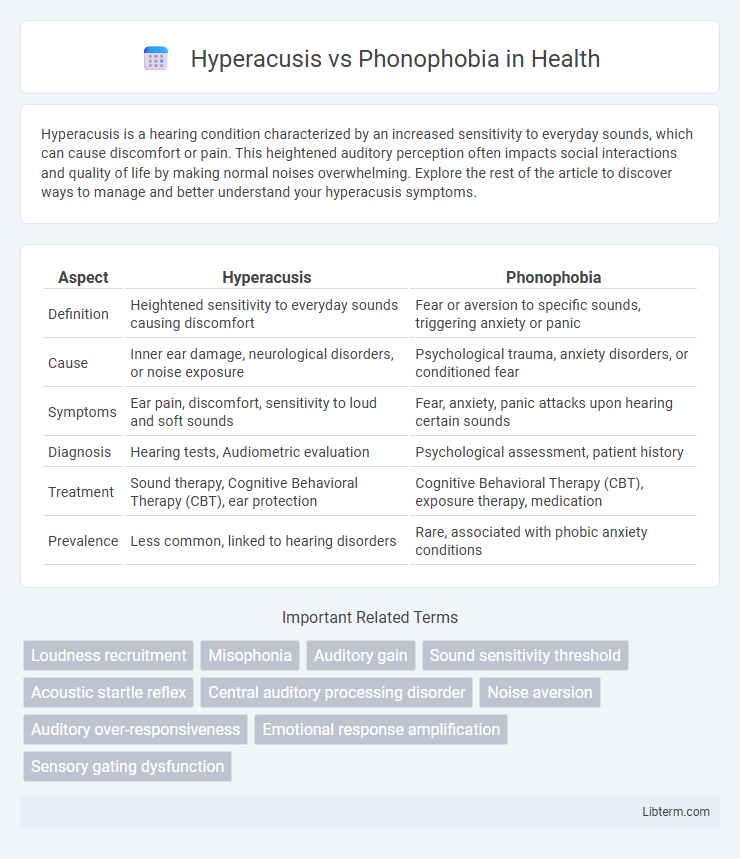Hyperacusis is a hearing condition characterized by an increased sensitivity to everyday sounds, which can cause discomfort or pain. This heightened auditory perception often impacts social interactions and quality of life by making normal noises overwhelming. Explore the rest of the article to discover ways to manage and better understand your hyperacusis symptoms.
Table of Comparison
| Aspect | Hyperacusis | Phonophobia |
|---|---|---|
| Definition | Heightened sensitivity to everyday sounds causing discomfort | Fear or aversion to specific sounds, triggering anxiety or panic |
| Cause | Inner ear damage, neurological disorders, or noise exposure | Psychological trauma, anxiety disorders, or conditioned fear |
| Symptoms | Ear pain, discomfort, sensitivity to loud and soft sounds | Fear, anxiety, panic attacks upon hearing certain sounds |
| Diagnosis | Hearing tests, Audiometric evaluation | Psychological assessment, patient history |
| Treatment | Sound therapy, Cognitive Behavioral Therapy (CBT), ear protection | Cognitive Behavioral Therapy (CBT), exposure therapy, medication |
| Prevalence | Less common, linked to hearing disorders | Rare, associated with phobic anxiety conditions |
Understanding Hyperacusis: Definition and Symptoms
Hyperacusis is characterized by an abnormal sensitivity to everyday sounds, causing discomfort or pain even at normal volumes. Symptoms include heightened auditory perception, ear pain, and difficulty tolerating common noises, often leading to emotional distress. Unlike phonophobia, which involves a fear- or anxiety-based reaction to sounds, hyperacusis primarily involves a physical hypersensitivity to sound stimuli.
Phonophobia Explained: Key Features and Triggers
Phonophobia is characterized by an intense, irrational fear of loud sounds, often accompanied by anxiety and panic attacks, distinguishing it from hyperacusis, which involves heightened sensitivity without the fear component. Key triggers include sudden noises such as alarms, sirens, or fireworks, as well as unpredictable everyday sounds that provoke emotional distress. This condition frequently overlaps with anxiety disorders and can lead to avoidance behaviors, significantly impacting quality of life.
Hyperacusis vs Phonophobia: Core Differences
Hyperacusis involves an increased sensitivity to normal environmental sounds, causing discomfort or pain, whereas Phonophobia is characterized by a fear or anxiety triggered by specific sounds, often linked to psychological factors. Hyperacusis primarily affects auditory processing pathways, leading to sensory overload, while Phonophobia is rooted in emotional and neurological responses to anticipated noise. Accurate diagnosis relies on distinguishing sensory hypersensitivity from sound-induced anxiety, guiding effective treatment strategies.
Underlying Causes: What Drives Each Condition?
Hyperacusis is primarily driven by an abnormal increase in central auditory system sensitivity, often linked to noise-induced hearing loss, head trauma, or neurological disorders such as migraine or Bell's palsy. Phonophobia, characterized by fear or anxiety triggered by specific sounds, is rooted in psychological conditions like anxiety disorders, post-traumatic stress disorder (PTSD), or phobias, where sound acts as a fear stimulus rather than purely sensory intolerance. Understanding these distinct underlying causes helps differentiate hyperacusis, a sensory processing disorder, from phonophobia, a psychological response to sound.
Diagnostic Approaches: Distinguishing Between the Two
Diagnostic approaches for hyperacusis and phonophobia rely on detailed patient history and specialized audiological assessments. Hyperacusis is evaluated through loudness discomfort levels (LDLs) and acoustic reflex testing to measure sound tolerance, while phonophobia diagnosis involves psychological evaluation to assess fear or anxiety responses to specific sounds. Differentiating the two requires correlating audiometric data with behavioral and emotional reactions to auditory stimuli.
Impact on Daily Life: Social, Emotional, and Functional Effects
Hyperacusis causes heightened sensitivity to everyday sounds, leading to discomfort and avoidance of social settings, which can result in isolation and increased anxiety. Phonophobia involves an intense fear of specific sounds, triggering panic attacks and emotional distress that disrupt daily routines and interpersonal relationships. Both conditions significantly impair functional activities by limiting one's ability to engage in normal environments, affecting overall quality of life.
Treatment Options for Hyperacusis
Treatment options for hyperacusis primarily include sound therapy, cognitive behavioral therapy (CBT), and the use of ear protection devices to gradually desensitize the auditory system. Sound therapy utilizes controlled exposure to low-level noise to retrain the brain's response to everyday sounds, reducing hypersensitivity over time. CBT addresses the emotional and psychological impacts of hyperacusis, helping patients manage anxiety and improve coping strategies.
Managing Phonophobia: Therapies and Strategies
Managing phonophobia involves cognitive-behavioral therapy (CBT) to reduce fear and anxiety related to sound sensitivity, combined with gradual sound exposure techniques that help desensitize patients. Custom sound therapy devices and relaxation exercises like diaphragmatic breathing can alleviate symptoms and improve coping mechanisms. Collaboration with audiologists and mental health professionals ensures a comprehensive treatment plan tailored to individual severity and triggers.
Prevention and Coping Mechanisms
Hyperacusis prevention involves protecting the ears from loud noises using earplugs and minimizing exposure to high-decibel environments to prevent auditory sensitivity. Phonophobia management includes cognitive-behavioral therapy (CBT) and gradual sound desensitization techniques to reduce fear responses to specific sounds. Both conditions benefit from mindfulness practices and stress reduction strategies to improve overall coping and resilience.
Seeking Professional Help: When and Where to Start
Seeking professional help for hyperacusis or phonophobia is crucial when everyday sounds trigger persistent discomfort or fear that impacts daily life. Audiologists and otolaryngologists are primary specialists who can diagnose and tailor treatment plans, while psychologists or psychiatrists may address associated anxiety or phobic reactions. Early consultation at specialized hearing clinics or mental health centers enhances the effectiveness of therapies such as sound desensitization, cognitive-behavioral therapy, and medication management.
Hyperacusis Infographic

 libterm.com
libterm.com